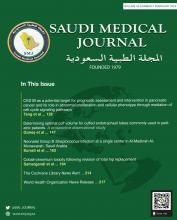Article Figures & Data
Tables
Variables n (%) Availability of CPET Yes 15 (28.8) No 37 (71.1) Apply CPET in hospital or medical Center (n=15) Regularly 11 (73.3) Not regular 4 (26.7) Department applying the CPET testing (n=11) Adult cardiology 6 (54.5) Exercise physiology 2 (18.2) Physical therapy 1 (9.1) Research center 1 (9.1) Respiratory therapy 1 (9.1) Healthcare provider supervises the exercise testing(n=11) Cardiologist 6 (54.5) Exercise physiologist 4 (36.4) Pulmonologist 1 (9.1) Number of technicians being involved in CPET in the unit (n=11) One technician 3 (27.3) 2 technicians 4 (36.4) 3 or more technicians 4 (36.4) Frequency of test per week for assessment 3 (1-10) Values are presented as numbers and precentages (%) or median and interquartile range (IQR). CPET: cardiopulmonary exercise testing
- Table 2
- Description of the cardiopulmonary exercise testing and referred clinical cases (n=11).
Characteristics n (%) Exercise mode Treadmill 10 (90.9) Leg ergometer 2 (18.2) Arm ergometer 1 (9.1) CPET protocol Modified Bruce protocol 10 (90.9) Balke protocol 2 (18.2) Naughton protocol 1 (9.1) Type of the workload Ramp protocol 3 (27.3) Standard incremental protocol 8 (72.8) Use of sensory scale for measuring exercise intensity Yes 6 (54.5) No 5 (45.4) Type of sensory scale used Rate of perceived exertion scale (RPE) 3 (50.0) Parameters usually used as the main predictor of the outcome during CPET Peak VO2 2 (18.2) Anaerobic threshold 4 (36.4) Heart rate threshold 2 (18.2) All 3 (27.3) Referred cases Metabolic 2 (18.2) Cardiac 7 (63.6) Pulmonary 3 (27.3) Cardiorespiratory fitness 3 (27.3) Most common cases Asymptomatic people 4 (36.4) Symptomatic people 2 (18.2) Both 5 (45.4) Values are presented as numbers and precentages (%).
CPET: cardiopulmonary exercise testing, VO2: maximal oxygen uptake
- Table 3
- Comparison between the cardiology and exercise physiology in the utilization of the cardiopulmonary exercise testing.
Characteristics Healthcare providers X2 test P-values Cardiologist (n=6) Exercise physiologist (n=4) Mode Treadmill 6 (100) 2 (50.0) 3.75 0.15 Leg ergometer 0 (0.0) 1 (25.0) Arm ergometer 0 (0.0) 1 (25.0) Workload Ramp protocol 0 (0.0) 2 (50.0) 3.75 0.05 Standard incremental protocol 6 (100) 2 (50.0) Cases Metabolic 0 (0.0) 1 (25.0) 7.91 0.04 Cardiac 5 (83.3) 0 (0.0) Pulmonary 1 (16.7) 1 (25.0) Cardiopulmonary fitness 0 (0.0) 2 (50.0) Stress electrocardiogram testing 5 (83.3) 1 (25.0) 6.428 0.011 Values are presented as numbers and precentages (%).
Parameters n (%) Heart rate 10 (90.9) O2 pulse 9 (81.8) Blood pressure 8 (72.7) Respiratory frequency 6 (54.5) Tidal volume 5 (45.4) O2 uptake 5 (45.4) Cardiac output 5 (45.4) Minute ventilation 4 (36.3) CO2 production 4 (36.3) Anaerobic threshold 3 (27.2) Blood lactate 3 (27.2) Respiratory quotient 3 (27.2) VE/VCO2 or VE/VO2 3 (27.2) Others 1 (9.0) Values are presented as numbers and precentages (%).
VE/VCO2: ventilatory equivalent of carbon dioxide,
VE/VO2: ventilatory equivalent of oxygen
Conditions Male Female Pediatric (6-17 years) 5 (33.3) 5 (33.3) Young adult (18-39 years) 4 (26.6) 1 (6.6) Middle age (40-59 years) 7 (46.6) 6 (40.0) Older people (≥60 years) 1 (6.6) 1 (6.6) Values are presented as numbers and precentages (%).
- Table 6
- Comparison of cardiopulmonary exercise testing findings reported by the current study and a previous survey carried out 2 decades ago.
Variables Al-Hazzaa et al8 (N=34) Current study (N=52) Availability of CPET Yes 5 (14.7) 15 (28.8) No 29 (85.4) 37 (71.1) Mode Treadmill 4 (80.0) 10 (90.9) Leg ergometer 3 (60.0) 2 (18.2) Arm ergometer 2 (40.0) 1 (9.1) Type of barriers Lack of trained technicians 10 (34.5) 31 (83.7) Lack of equipment 12 (41.4) 34 (91.8) Lack of training in interpreting the results 9 (31.0) 15 (40.5) Time consuming 1 (3.4) 1 (2.7) No cardiologist available 0 (0.0) 1 (2.7) Not totally convinced of its diagnostic value 1 (3.4) 1 (2.7) Healthcare provider supervising the exercise testing Cardiologist 3 (60.0) 6 (54.5) Exercise physiologist 2 (40.0) 4 (36.4) Pulmonologist 0 (0.0) 1 (9.1) Values are presented as numbers and precentages (%). CPET: cardiopulmonary exercise testing






